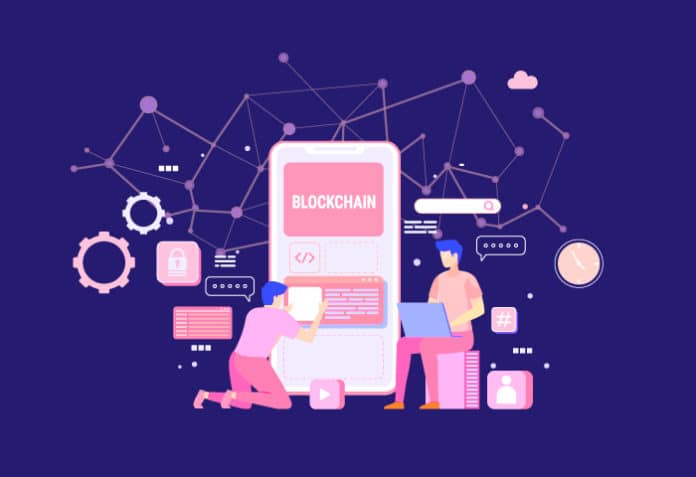A blockchain stores data in such a way that it is almost impossible to alter or hack it. In this article, we will go through the key features of the blockchain, look at blockchain development platforms, and view the steps in the blockchain mobile app development process.
The first instances of blockchain based apps that swept the world were cryptocurrency solutions like Bitcoin, which allowed anyone to join a decentralised blockchain network and provide a cross-verification based network for secure transactions.
For more than a decade, blockchain based apps have reigned supreme. More than 70 million people use blockchain based wallets around the world. According to Grand View Research, the global market for blockchain technology was valued at US$ 3.67 billion in 2020 and is expected to grow at an annual rate of 82.4 per cent until 2028. As a result, the future of blockchain mobile apps is bright.
Some examples of blockchain apps
While blockchain development made its start with cryptocurrencies, it is hardly restricted to this today. Now, blockchain applications have transcended cryptocurrencies and spread to many other fields.
As we all know, the main benefit of blockchain technology is that it ensures maximum data transparency and security, helping businesses and organisations save a significant amount of money on standard security methods.
The following are some useful blockchain apps.
Filament: This is an excellent example of a blockchain based IoT app that uses blockchain data ledger systems to manage data processed by software and microchip hardware. Several linked devices can communicate information over the blockchain and keep in sync with the help of the app.
KYC-chain: For many firms, completing Know Your Customer (KYC) documentation is a must. This simple and effective blockchain based program streamlines the entire process of handling client documentation across administrative and criminal databases in many nations.
BurstIQ: BurstIQ is healthcare software that uses Big Data and blockchain technology to allow patients and doctors to share and collaborate on vital medical information.
Blockchain development platforms
There are more than two dozen blockchain development platforms. A few are described below.
Multichain: With this powerful platform, developers can create and deploy private blockchains that can be used by a variety of businesses.
Hyperledger: This distributed ledger technology is used to govern the connected ecosystem of things and supply chains. This advanced blockchain platform has received a lot of acclaim.
Ethereum: A versatile open source blockchain technology, Ethereum is commonly used for decentralised apps, smart contracts and initial coin offerings (ICOs).
EOS: The EOS platform’s goal is to create a reliable smart contract function. It’s also appropriate for modern businesses’ need for highly scalable and decentralised storage and hosting.
Blockchain platforms come in a variety of shapes and sizes. Confusion arises in determining which platform is better and suited to one’s application needs. The answer depends on the use cases and capabilities sought.
Choosing the most appropriate platform: The key to your project’s success lies in determining the platform’s character. Platforms based on cryptocurrencies as well as those based on smart contracts are available.
Decide whether you need smart contracts or not: You need to determine if your app needs smart contracts or not.
Selecting the consensus protocol: The consensus protocol ensures that every new block added to the blockchain is the only version of the truth that all nodes in the blockchain agree on, such as proof of stake, proof of work, proof of elapsed time, and so on.
Choosing the cryptocurrency: Another challenge is determining whether or not a cryptocurrency is required.
Selecting between a public and private network: Based on the requirement, you need to decide whether a public or a private network is needed.
Process of blockchain mobile app development
There are mainly five stages in the blockchain app development process.
1. Identify the problem that the blockchain is required to solve: First, conduct a thorough examination of the problem statement and write a comprehensive report on it. Also consider whether you need to design an app from the ground up or if you can just integrate the blockchain into an existing app.
2. Select the best platform for the app: Choose the best platform for your app. Determine whether a smart contract app or a crypto-transaction app is required, as well as the type of network and consensus protocol required, among other things.
3. Requirement analysis: Begin by doing the requirement analysis and evaluating the app idea’s requirements. Do more brainstorming around the idea and, if possible, fine tune it.
4. Create a blueprint of the idea: Try to develop the proof of concept that will put the entire app concept into a visual structure.
5. Development of the application: Develop the application employing best practices. Ensure to build a robust blockchain app.
We’ve covered the basics of blockchain in this essay — its main characteristics, as well as several development platforms and stages for developing blockchain applications. If you find the subject interesting, you can delve deeper into it. There are a variety of resources available on the Internet.
















































































